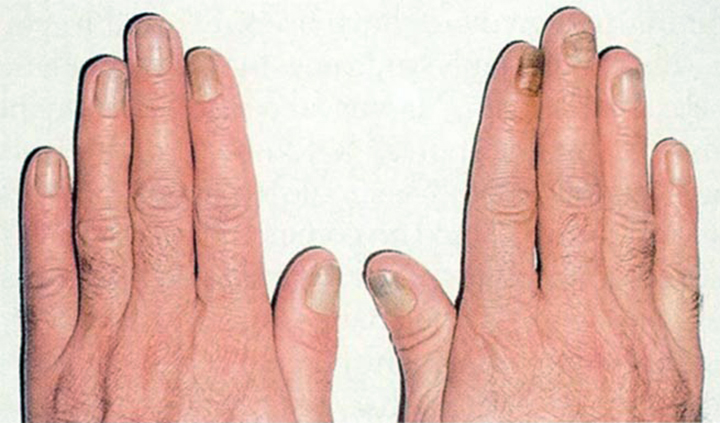Yellow nail syndrome is much more than stained nails. This rare disorder causes nail and respiratory symptoms. It can also cause fluid buildup and swelling in your lower legs. The most common sign of this syndrome is thick, yellow nails. Your nails may also break away from your skin and fall off.
Advertisement
Cleveland Clinic is a non-profit academic medical center. Advertising on our site helps support our mission. We do not endorse non-Cleveland Clinic products or services. Policy

Yellow nail syndrome is a rare condition that affects your nails, lungs and limbs. People with yellow nail syndrome get yellow, curved nails that may thicken or fall off. They also may have respiratory symptoms, such as a chronic cough, and usually have swollen lower legs or ankles.
Advertisement
Cleveland Clinic is a non-profit academic medical center. Advertising on our site helps support our mission. We do not endorse non-Cleveland Clinic products or services. Policy
Experts don’t know what causes yellow nail syndrome. But it may be linked to improper circulation, issues with lymphatic drainage or buildup of fluid around your lungs. You may also have a higher risk if you have one of a few specific chronic diseases, dental implants or a joint replacement.
Yellow nail syndrome develops most often in adults over 50. More rarely, yellow nail syndrome sometimes occurs in children.
Some reports show higher rates of yellow nail syndrome in people with:
Experts don’t know exactly how many people have yellow nail syndrome. But we do know the condition is rare. Medical journals have reported around 100 cases of yellow nail syndrome.
Yellow nail syndrome has three main types of symptoms:
Advertisement
Yellow nail syndrome is more than discolored or stained nails. Many people have yellow nails without having yellow nail syndrome. For example, you may have yellowish nails for a short time after removing dark nail polish. But if the color doesn’t go away within a few weeks, or if you have other symptoms, see your healthcare provider.
The hallmark sign of yellow nail syndrome is yellowish nails that curve and thicken. You may experience:
Experts don’t know what causes yellow nail syndrome. Most people develop the syndrome for no known reason.
Some experts believe that yellow nail syndrome results from issues with your circulatory or lymphatic system. When these systems don’t work as they should, it can cause fluid to collect in the soft tissues under your skin. In turn, this may turn your nails yellow.
Some researchers think that yellow nail syndrome is genetic. There may be a link between a mutation (change) in the FOXC2 gene and yellow nail syndrome. FOXC2 gene mutations cause a condition called lymphedema-distichiasis syndrome. This condition has similar symptoms to yellow nail syndrome.
Other researchers think there’s a link between yellow nail syndrome and titanium exposure. Joint replacements, dental implants and certain medications can increase your titanium exposure. But most people with titanium implants don’t develop yellow nail syndrome.
Usually, your healthcare provider can diagnose yellow nail syndrome based on your symptoms. You may also have:
Yellow nails could point to many conditions, such as a fungal infection or psoriasis. But if you have yellow nails along with respiratory symptoms, your healthcare provider might need to rule out yellow nail syndrome.
Your healthcare provider will treat yellow nail syndrome according to the suspected underlying cause or condition. For example, if they suspect improper lymph drainage, they may recommend specialized massage to help improve your circulation. If yellow nail syndrome is associated with excess fluid around your lungs, your healthcare provider may recommend a procedure to drain the fluid.
Other yellow nail syndrome treatments may include:
Advertisement
In some people, symptoms may disappear completely. Nail symptoms may improve in up to 1 in 3 people who get treatment for yellow nail syndrome. Respiratory symptoms and swelling may also go away. But you may need to see your healthcare provider regularly to keep symptoms at bay.
Many people manage yellow nail syndrome long term. Especially if you have severe swelling or respiratory problems, you’ll likely need ongoing management.
No. Although yellow nail syndrome can cause serious symptoms, it isn’t usually fatal. Especially if you seek treatment as soon as you notice symptoms, the outlook is typically good. Most people with yellow nail syndrome have a typical life expectancy.
There’s no guaranteed way to prevent yellow nail syndrome. If you have titanium implants, pay attention to symptoms that could point to yellow nail syndrome and see your healthcare provider if you have pain or discomfort. If you have a relative who had problems with a dental or surgical implant, speak with your healthcare provider about your risks before getting an implant.
You may want to ask your healthcare provider:
Advertisement
Vitamin E deficiency may lead to yellow-colored nails. So can many other vitamin deficiencies or conditions. If you have yellow nails, see your healthcare provider for diagnosis and treatment.
Yellow nail syndrome is a rare nail disorder. It causes yellow nails, respiratory problems and leg swelling. Experts don’t know what causes yellow nail syndrome, but it may be genetic. You’re also more likely to develop yellow nail syndrome if you have certain autoimmune conditions, thyroid disease or rheumatoid arthritis. Treatment may include vitamin E supplements, medications or massage to reduce swelling.
Advertisement
Every day, people see your skin, hair and nails. At Cleveland Clinic, our expert and caring dermatology team will make sure they’re healthy and strong.

Last reviewed on 05/16/2022.
Learn more about the Health Library and our editorial process.